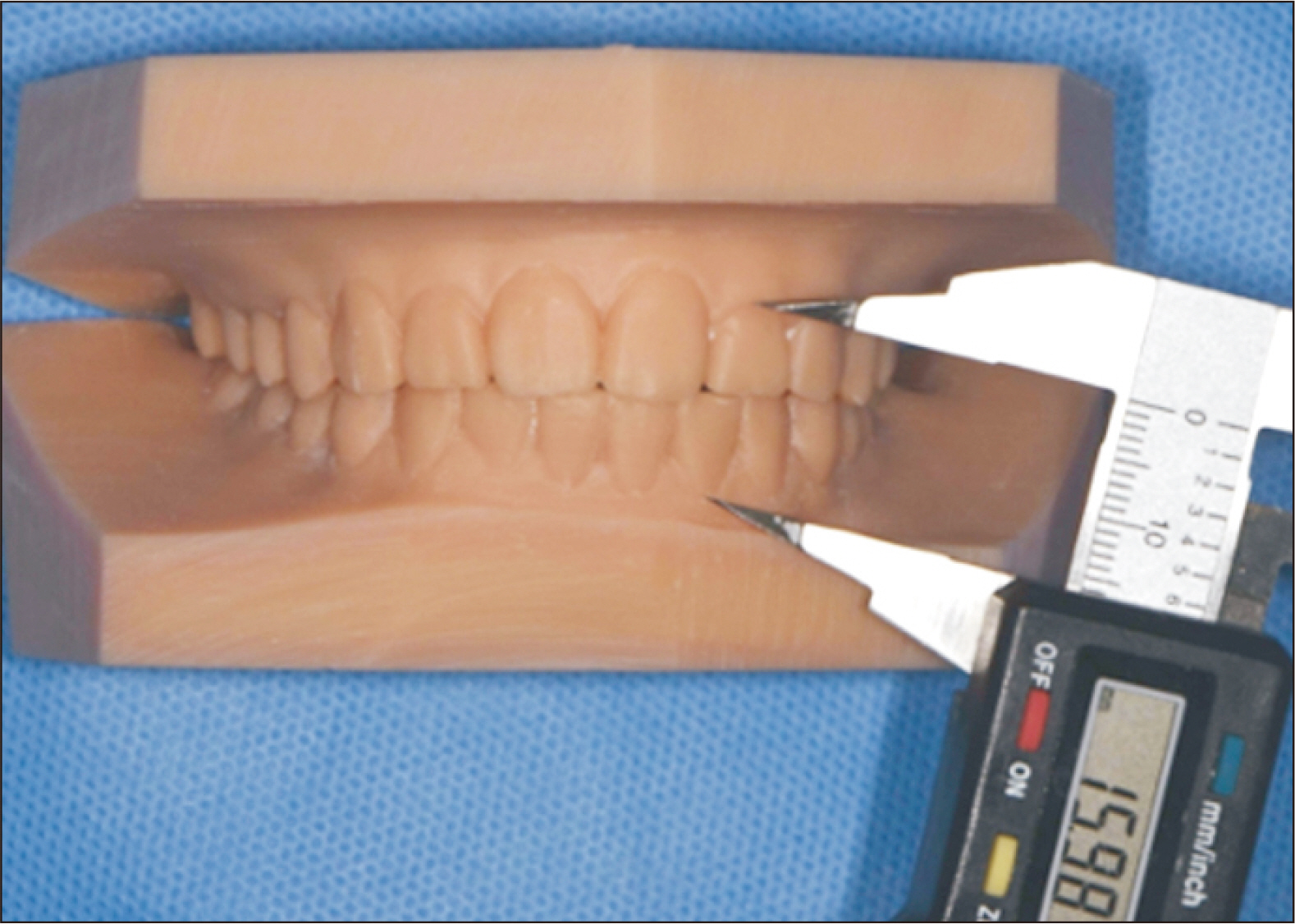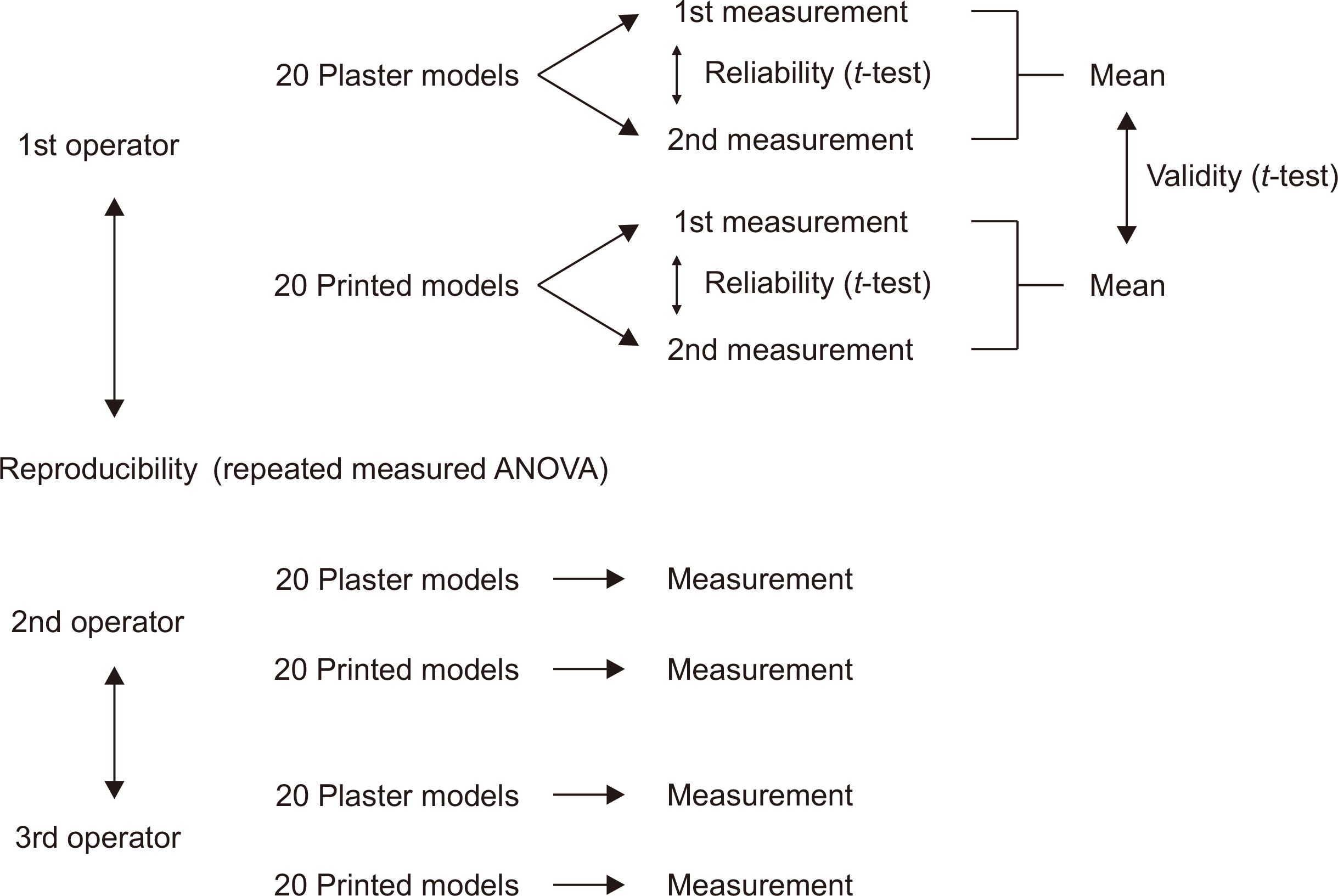Korean J Orthod.
2022 Jan;52(1):20-28. 10.4041/kjod.2022.52.1.20.
Evaluation of accuracy of 3-dimensional printed dental models in reproducing intermaxillary relational measurements: Based on inter-operator differences
- Affiliations
-
- 1Department of Medicine, Gachon University Graduate School, Incheon, Korea
- 2Department of Orthodontics, Gil Medical Center, Gachon University College of Medicine, Incheon, Korea
- KMID: 2524899
- DOI: http://doi.org/10.4041/kjod.2022.52.1.20
Abstract
Objective
Although, digital models have recently been used in orthodontic clinics, physical models are still needed for a multitude of reasons. The purpose of this study was to assess whether the printed models can replace the plaster models by evaluating their accuracy in reproducing intermaxillary relationships and by appraising the clinicians’ ability to measure the printed models.
Methods
Twenty sets of patients’ plaster models with well-established occlusal relationships were selected. Models were scanned using an intraoral scanner (Trios 3, 3Shape Dental System) by a single operator. Printed models were made with ZMD-1000B light-curing resin using the stereolithography method 3-dimensional printer. Validity, reliability, and reproducibility were evaluated using measurements obtained by three operators.
Results
In evaluation of validity, all items showed no significant differences between measurements taken from plaster and printed models. In evaluation for reliability, significant differences were found in the distance between the gingival zeniths of #23–#33 (DZL_3) for the plaster models and at #17–#43 (DZCM_1) for the printed models. In evaluation for reproducibility, the plaster models showed significant differences between operators at midline, and printed models showed significant differences at 7 measurements including #17–#47 (DZR_7).
Conclusions
The validity and reliability of intermaxillary relationships as determined by the printed model were clinically acceptable, but the evaluation of reproducibility revealed significant inter-operator differences. To use printed models as substitutes for plaster models, additional studies on their accuracies in measuring intermaxillary relationship are required.
Figure
Reference
-
1. Bell A, Ayoub AF, Siebert P. 2003; Assessment of the accuracy of a three-dimensional imaging system for archiving dental study models. J Orthod. 30:219–23. DOI: 10.1093/ortho/30.3.219. PMID: 14530419.
Article2. Council of Faculty of Orthodontics. 2006. Textbook of orthodontics. 2nd ed. DaehanNarae Publishing Inc.;Seoul: p. 170–2.3. Fleming PS, Marinho V, Johal A. 2011; Orthodontic measurements on digital study models compared with plaster models: a systematic review. Orthod Craniofac Res. 14:1–16. DOI: 10.1111/j.1601-6343.2010.01503.x. PMID: 21205164.
Article4. Stevens DR, Flores-Mir C, Nebbe B, Raboud DW, Heo G, Major PW. 2006; Validity, reliability, and reproducibility of plaster vs digital study models: comparison of peer assessment rating and Bolton analysis and their constituent measurements. Am J Orthod Dentofacial Orthop. 129:794–803. DOI: 10.1016/j.ajodo.2004.08.023. PMID: 16769498.
Article5. 2015. Enforcement Regulation of the Medical Law, Korea. Article 15 [Internet]. Ministry of Health and Welfare;Available from: https://www.law.go.kr/LSW/lsInfoP.do?efYd=20210301&lsiSeq=196454#0000. updated 2016 Dec 29; cited 2020 Mar 2.6. Korean Association of Orthodontists. Legal advice no. 324, 492 [Internet]. Korean Association of Orthodontists;Available from: https://www.kao.or.kr/board/list.html?code=lawfirm. updated 2018 Aug 1; cited 2020 Mar 2.7. Mizrahi E. 2010; Risk management in clinical practice. Part 7. Dento-legal aspects of orthodontic practice. Br Dent J. 209:381–90. DOI: 10.1038/sj.bdj.2010.926. PMID: 20966997.
Article8. Charangowda BK. 2010; Dental records: an overview. J Forensic Dent Sci. 2:5–10. DOI: 10.4103/0974-2948.71050. PMID: 21189983. PMCID: PMC3009547.
Article9. Wiranto MG, Engelbrecht WP, Tutein Nolthenius HE, van der Meer WJ, Ren Y. 2013; Validity, reliability, and reproducibility of linear measurements on digital models obtained from intraoral and cone-beam computed tomography scans of alginate impressions. Am J Orthod Dentofacial Orthop. 143:140–7. DOI: 10.1016/j.ajodo.2012.06.018. PMID: 23273370.
Article10. Hazeveld A, Huddleston Slater JJ, Ren Y. 2014; Accuracy and reproducibility of dental replica models reconstructed by different rapid prototyping techniques. Am J Orthod Dentofacial Orthop. 145:108–15. DOI: 10.1016/j.ajodo.2013.05.011. PMID: 24373661.
Article11. Wan Hassan WN, Yusoff Y, Mardi NA. 2017; Comparison of reconstructed rapid prototyping models produced by 3-dimensional printing and conventional stone models with different degrees of crowding. Am J Orthod Dentofacial Orthop. 151:209–18. DOI: 10.1016/j.ajodo.2016.08.019. PMID: 28024776.
Article12. Camardella LT, de Vasconcellos Vilella O, Breuning H. 2017; Accuracy of printed dental models made with 2 prototype technologies and different designs of model bases. Am J Orthod Dentofacial Orthop. 151:1178–87. DOI: 10.1016/j.ajodo.2017.03.012. PMID: 28554463.
Article13. Yourtee D, Emery J, Smith RE, Hodgson B. 2000; Stereolithographic models of biopolymers. J Mol Graph Model. 18:26–8. 59–60. DOI: 10.1016/S1093-3263(00)00029-2. PMID: 10935203.
Article14. Raju BS, Chandrashekar U, Drakshayani DN, Chockalingam K. 2010; Determining the influence of layer thickness for rapid prototyping with Stereolithography (SLA) process. Int J Eng Sci Technol. 2:3199–205.15. Cuperus AM, Harms MC, Rangel FA, Bronkhorst EM, Schols JG, Breuning KH. 2012; Dental models made with an intraoral scanner: a validation study. Am J Orthod Dentofacial Orthop. 142:308–13. DOI: 10.1016/j.ajodo.2012.03.031. PMID: 22920696.16. Brown GB, Currier GF, Kadioglu O, Kierl JP. 2018; Accuracy of 3-dimensional printed dental models reconstructed from digital intraoral impressions. Am J Orthod Dentofacial Orthop. 154:733–9. DOI: 10.1016/j.ajodo.2018.06.009. PMID: 30384944.
Article17. Anh JW, Park JM, Chun YS, Kim M, Kim M. 2016; A comparison of the precision of three-dimensional images acquired by 2 digital intraoral scanners: effects of tooth irregularity and scanning direction. Korean J Orthod. 46:3–12. DOI: 10.4041/kjod.2016.46.1.3. PMID: 26877977. PMCID: PMC4751299.
Article18. Loflin WA, English JD, Borders C, Harris LM, Moon A, Holland JN, et al. 2019; Effect of print layer height on the assessment of 3D-printed models. Am J Orthod Dentofacial Orthop. 156:283–9. DOI: 10.1016/j.ajodo.2019.02.013. PMID: 31375239.
Article19. Naidu D, Freer TJ. 2013; Validity, reliability, and reproducibility of the iOC intraoral scanner: a comparison of tooth widths and Bolton ratios. Am J Orthod Dentofacial Orthop. 144:304–10. DOI: 10.1016/j.ajodo.2013.04.011. PMID: 23910212.
Article20. Darroudi AM, Kuijpers-Jagtman AM, Ongkosuwito EM, Suttorp CM, Bronkhorst EM, Breuning KH. 2017; Accuracy of a computed tomography scanning procedure to manufacture digital models. Am J Orthod Dentofacial Orthop. 151:995–1003. DOI: 10.1016/j.ajodo.2016.12.013. PMID: 28457278.
Article21. Camardella LT, Ongkosuwito EM, Penning EW, Kuijpers-Jagtman AM, Vilella OV, Breuning KH. 2020; Accuracy and reliability of measurements performed using two different software programs on digital models generated using laser and computed tomography plaster model scanners. Korean J Orthod. 50:13–25. DOI: 10.4041/kjod.2020.50.1.13. PMID: 32042716. PMCID: PMC6995834.
Article22. Porter JL, Carrico CK, Lindauer SJ, Tüfekçi E. 2018; Comparison of intraoral and extraoral scanners on the accuracy of digital model articulation. J Orthod. 45:275–82. DOI: 10.1080/14653125.2018.1500773. PMID: 30024348.
Article23. Yoo JK, Kang YK, Lee SJ, Kim SH, Moon CH. 2020; Accuracy of inter-arch measurements performed on digital models generated using two types of intraoral scanners: ex vivo study. J Korean Dent Assoc. 58:194–205.24. Wesemann C, Muallah J, Mah J, Bumann A. 2017; Accuracy and efficiency of full-arch digitalization and 3D printing: a comparison between desktop model scanners, an intraoral scanner, a CBCT model scan, and stereolithographic 3D printing. Quintessence Int. 48:41–50. DOI: 10.3290/j.qi.a37130. PMID: 27834416.25. Saleh WK, Ariffin E, Sherriff M, Bister D. 2015; Accuracy and reproducibility of linear measurements of resin, plaster, digital and printed study-models. J Orthod. 42:301–6. DOI: 10.1179/1465313315Y.0000000016. PMID: 26216658.
Article26. Hayashi K, Sachdeva AU, Saitoh S, Lee SP, Kubota T, Mizoguchi I. 2013; Assessment of the accuracy and reliability of new 3-dimensional scanning devices. Am J Orthod Dentofacial Orthop. 144:619–25. DOI: 10.1016/j.ajodo.2013.04.021. PMID: 24075671.
Article27. Sherman SL, Kadioglu O, Currier GF, Kierl JP, Li J. 2020; Accuracy of digital light processing printing of 3-dimensional dental models. Am J Orthod Dentofacial Orthop. 157:422–8. DOI: 10.1016/j.ajodo.2019.10.012. PMID: 32115120.
Article28. American Board of Orthodontics. 2013. Digital model and 3D printing requirements [Internet]. American Board of Orthodontics;Available from: https://www.americanboardortho.com/media/1157/abo-digital-model-requirements.pdf. updated 2016 Jun 30; cited 2019 Nov 11.29. Camardella LT, Vilella OV, van Hezel MM, Breuning KH. 2017; Accuracy of stereolithographically printed digital models compared to plaster models. J Orofac Orthop. 78:394–402. DOI: 10.1007/s00056-017-0093-1. PMID: 28361165.
Article30. Rebong RE, Stewart KT, Utreja A, Ghoneima AA. 2018; Accuracy of three-dimensional dental resin models created by fused deposition modeling, stereolithography, and Polyjet prototype technologies: a comparative study. Angle Orthod. 88:363–9. DOI: 10.2319/071117-460.1. PMID: 29509023. PMCID: PMC8288316.
Article31. Reuschl RP, Heuer W, Stiesch M, Wenzel D, Dittmer MP. 2016; Reliability and validity of measurements on digital study models and plaster models. Eur J Orthod. 38:22–6. DOI: 10.1093/ejo/cjv001. PMID: 25724574.
Article32. Westerlund A, Tancredi W, Ransjö M, Bresin A, Psonis S, Torgersson O. 2015; Digital casts in orthodontics: a comparison of 4 software systems. Am J Orthod Dentofacial Orthop. 147:509–16. DOI: 10.1016/j.ajodo.2014.11.020. PMID: 25836011.
Article
- Full Text Links
- Actions
-
Cited
- CITED
-
- Close
- Share
- Similar articles
-
- Accuracy and precision of measurements performed on three-dimensional printed pelvises when compared to computed tomography measurements
- The comparative study of three-dimensional cephalograms to actual models and conventional lateral cephalograma in linear and angular measurements
- Accuracy and precision of polyurethane dental arch models fabricated using a three-dimensional subtractive rapid prototyping method with an intraoral scanning technique
- Assessment of the accuracy of laser-scanned models and 3-dimensional rendered cone-beam computed tomographic images compared to digital caliper measurements on plaster casts
- ACCURACY OF IMPROVED STONE CASTS FROM ELASTOMERIC IMPRESSION MATERIALS




